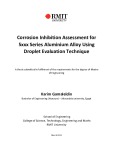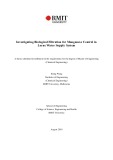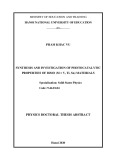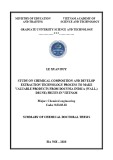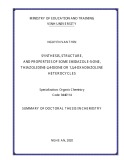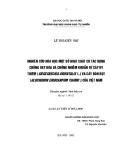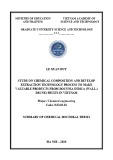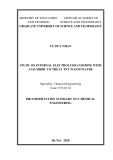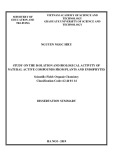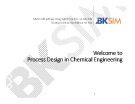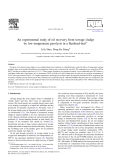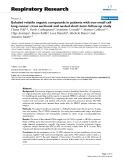VIETNAM NATIONAL UNIVERSITY – HO CHI MINH CITY
HO CHI MINH UNIVERSITY OF TECHNOLOGY
----&&*&&----
NGUYỄN VĂN TÚ
INTRODUCING FLUORINE AND TRIFLUOROMETHYL
GROUP INTO ORGANIC COMPOUNDS UNDER
HETEROGENEOUS TRANSITION METAL CATALYSIS
Major: Chemical Engineering
Major Code: 62.52.03.01
PhD THESIS SUMMARY
HO CHI MINH CITY, 2018
The thesis was accomplished in Ho Chi Minh University of Technology - Vietnam National University - Ho Chi Minh City
Advisors: 1) Prof. Dr. Phan Thanh Sơn Nam
2) Dr. Trương Vũ Thanh
Independent Reviewer No.1:
Independent Reviewer No.2:
Reviewer No.1:
Reviewer No.2:
Reviewer No.3:
The thesis was defended before the scientific committee at the Faculty of
Chemical Engineering, Ho Chi Minh University of Technology, Vietnam
National University - Ho Chi Minh City
On the .........................................................
The thesis information can be found at following libraries:
- General Science Library - Ho Chi Minh City
- Library of Ho Chi Minh University of Technology, Vietnam National
University - Ho Chi Minh City
2
VIETNAM NATIONAL UNIVERSITY – HO CHI MINH CITY
HO CHI MINH UNIVERSITY OF TECHNOLOGY
----&&*&&----
NGUYỄN VĂN TÚ
INTRODUCING FLUORINE AND TRIFLUOROMETHYL
GROUP INTO ORGANIC COMPOUNDS UNDER
HETEROGENEOUS TRANSITION METAL CATALYSIS
Major: Chemical Engineering
Major Code: 62520301
PhD THESIS SUMMARY
HO CHI MINH CITY, 2018
3
The thesis was accomplished in Ho Chi Minh University of Technology - Vietnam National University - Ho Chi Minh City
Advisors: 1) Prof. Dr. Phan Thanh Sơn Nam
2) Dr. Trương Vũ Thanh
Independent Reviewer No.1:
Independent Reviewer No.2:
Reviewer No.1:
Reviewer No.2:
Reviewer No.3:
The thesis was defended before the scientific committee at the Faculty of
Chemical Engineering, Ho Chi Minh University of Technology, Vietnam
National University - Ho Chi Minh City
On the .........................................................
The thesis information can be found at following libraries:
- General Science Library - Ho Chi Minh City
- Library of Ho Chi Minh University of Technology, Vietnam National
University - Ho Chi Minh City
4
LIST OF PUBLICATIONS
1. Tu V. Nguyen, Toan D. Ong, Anh H.M. Lam, Vu. T. Pham, Nam T.S. Phan, Thanh Truong, Nucleophilic trifluormethylation of aryl boronic acid under heterogeneous Cu(INA)2 catalysis at room temperature: The catalytic copper-based protocol. Molecular Catalysis, 2017. 436: p. 60-66. (DOI: 10.016/j.mcat.2017.04.010) (IF = 4.0) 2. Tu V. Nguyen, Vu T. Pham, Tin V.T. Nguyen, Nam T.S. Phan, Thanh Truong, Decarboxylative fluorination of aliphatic carboxylic acids under heterogeneous delafossite AgFeO2 nanoparticle catalysis: the utilization of bimetallic cooperativity. Journal of Catalysis, 2018. 360: p. 270–276. (DOI: 10.1016/j.jcat.2018.02.018) (IF = 7.0)
5
INTRODUCTION
The organofluoride compounds are the least common natural ones compared to
the other organohalides. Most organofluorides found in the earth are insoluble,
averting the uptake of bioorganisms. However, the fluorine containing groups
are of precious characteristics in pharmaceuticals, agrochemicals and materials
bioavailability. Besides, for Positron Emission
due to their enhanced electronegativity, lipophilicity, metabolic stability and 18F-radiotracers used remarkably applied to both diagnosis and Tomography (PET) are
pharmaceutical development. Not until 1970 had fluorinated drugs been
prevalent in medicinal chemistry. Since then, there has been a significant
growth in fluorine chemistry, especially over the last 20 years. Until 2002, more
than 150 fluorine containing drugs have come to market, estimably contributed
to ca. 20-25% of all pharmaceuticals, and even higher in agrochemicals with ca.
28% in market. Of 31 new drugs licensed in USA in 2002, nine contained
fluorine in their scaffolds. In 2006, Lipitor ® (atorvastatin calcium, which
contains one fluorine) and Advair ® (a mixture of fluticasone propionate and
salmeterol, which contains three fluorine atoms) are orderly the best- and the
second-best-selling pharmaceuticals over the world.
In spite of the importance of fluorinated frameworks in actual areas, the number
of these compounds in nature is rare. Therefore, the investigations to figure out
novel strategies to synthesize fluorinated products are needed. Of strategies, the
developments of simple handling, facile and inexpensive methods have been
attracting a great deal of attention.
Almost previous studies employed homogeneous catalysts that could not be
recovered and reused after reactions. Most of protocols proceeded under harsh
6
or costly conditions owing to the usage of the reagents susceptible to benchtop
setup or the expensive reagents, respectively, or both. Additionally, the
substrate scope and functional group tolerance still remain challenging. Further
studies, therefore, are required to ameliorate the disadvantages in the former
works. From above observations, we propose the thesis: “Introducing fluorine
and trifluoromethyl group into organic compounds under heterogeneous
transition metal catalysis”.
The purpose of the thesis is to develop the novel and more effective strategies
to furnish fluorine containing compounds employing readily, inexpensive and
effective methods under heterogeneous transition metal catalysts. Moreover, the
wide scope and functional group tolerance are also under our consideration.
From our knowledge, there has been no work utilizing the heterogeneous
catalysts to introduce fluorine into organic molecules so far. This is a important
factor to publish our accomplished studies in ISI ranked magazines with high IF
factor.
The inexpensive transition metal such as copper, iron, manganese, cobalt, silver
under nanoparticles and metal organic frameworks (MOFs) are applied to
discover the reactivity in model reactions. Additionally, numerous feedstocks
ranging from aromatics, heteroaromatics, alkynes, alkenes to aliphatic
compounds bearing various functional groups are used to develop the novel
strategies under readily, effective conditions. Moreover, the consideration to
pick the inexpensive fluorine and fluorine containing group transfer reagents is
also our priority in the studies.
In the sphere of our thesis, the investigations are conducted over a variety of
organic scaffolds delivered by prestigious providers such as Sigma Aldrich,
7
Acros Organics and Merck, using nanoparticles and MOFs of transition metals
as catalysts in the presence of inexpensive fluorinated reagents.
Our studies will contribute to current knowledge of fluorine chemistry the novel
methods employing heterogeneous catalysts to introduce fluorine and fluorine
containing groups into organomolecules which have not yet been developed
ever before. Our investigations are also carried out to ameliorate drawbacks in
previous studies so far, proving the importance and the practice of our work.
Furthermore, we establish the new methods for the usage of heterogeneous
catalysts in fluorine chemistry that can be restored and recycled many times
after reactions, making the methods more inexpensive.
Our studies are the first investigations in using heterogeneous transition metal
catalysts for introduction of fluorine and fluorine containing groups into
organic scaffolds. The first time Cu(INA)2 MOFs is employed in the trifluoromethylation of boronic acids, and the first time AgFeO2 nanoparticles is used in the fluorination of aliphatic acids. Thus, they make up vitally
practical approaches to synthesize the fluorinated products that are neccessary
in pharmaceuticals, agrochemicals and materials due to unique effects of
fluorine and fluorine containing groups on organomolecules. Our results may
make a turning point in the application of methods using heterogeneous
catalysts in fluorine chemistry.
8
CHAPTER 1. LITERATURE REVIEW
Fluorine and fluorinated groups have the strong effects on the properties of
organic compounds due to their enhancement of lipophilicity, metabolic
stability, bioactivity and binding selectivity. Therefore, more and more
fluorinated compounds have been used in medicinal chemistry, even higher in
agrochemicals. Several fluorinated products have come to the market and have
been also the top-selling products over years.
Though the necessity of fluorine containing compounds in pharmaceuticals, agrochemicals, materials and PET, and fluorine is the 13rd most abundant element in the earth’s crust, the availably natural fluorinated compounds are
rare. As a result, a great number of studies have been done to elicit numerous
methods for introduction of fluorine and fluorine containing groups into organic
frameworks, especially after 1970s. Different substrates, reagents, additives,
promoters and catalysts have been employed to develop various approaches in
the syntheses of fluorine containing scaffolds. Of reported works, the
attachment of fluorine and trifluoromethyl groups is most prevalent and has
attracted increasing attention from researchers over the world. Generally, more
and more effective, inexpensive works have been conducted to ameliorate the
drawbacks of the previous ones. However, the regioselectivity, substrate scope
and functional group tolerance still remain problematic so far.
In this thesis, we summarize the previous works corresponding to the
mechanism, focusing on two major fields that have attracted an increasing
attention from the scientific community. These are the fluorination and the
trifluoromethylation of organic scaffolds. We herein describe the methods in
9
general, analyze the pros and cons of developed methods basing upon the
transformational, economical efficiency and environmental green.
1.1 Introduction of fluorine into organic scaffolds
Previous studies showed different methods to introduce fluorine into organic
molecules using various fluorinating reagents as the fluorine transfer sources. In
general, there are three ultimate mechanisms of fluorination reactions including
electrophilic fluorination, nucleophilic fluorination and radical fluorination.
The early developments using strongly fluorine transfer reagents, namely
fluorine gas, fluorine solution, hypofluorites, fluoroxysulfates and perchloryl
fluoride coped with their high reactivity resulting in the difficulty of C-F bond
formation due to the generation of a number of isomers. Xenon fluoride then
exhibited the more stable reactivity than above reagents, but its high oxidizing
potential restricted the substrate scope with limited functional group tolerance.
Fortunately, the successful syntheses of N-fluoro reagent classes made a
watershed in the fluorine chemistry, and certainly they are still used in fluorine
synthesis to date. N-fluoro reagents such as N-fluorobis(phenyl)sulfonimide
(NFSI) and related analogs, N-fluoropyridinium salts, and 1-chloromethyl-4-
fluoro-1,4-diazoniabicyclo [2.2.2]octane bis(tetrafluoroborate) (Selectfluor®,
F-TEDA-BF4) have gone dominant compared to the early reagents due to their air-setup stability, regioselectivity and functional group tolerance. This is
demonstrated by that they have been used in the multitude of investigations
from the beginning time so far.
Generally, the subsequent developments have been of a lot of advantages over
the previous ones, such as the lower reaction temperature, high
chemoselectivity and regioselectivity, easy manipulation, wide substrate scope
10
and variously functional group tolerance. However, such investigations are rare
and the more developments are needed to ameliorate either most or all of
drawbacks existing in previous studies.
The fluorination of aliphatic acids has just been explored recent years, and it
has prodded a number of groups over the world. The single electron transfer
and radical pathways are the main ones for this transformation. However, the
low substrate scope and the expensive procedure are the disadvantages of this
approach.
1.2 Introduction of trifluoromethyl group into organic scaffolds
Similar to the introduction of fluorine into organic compounds, that of
trifluoromethyl group into organic compounds has attracted much attention
from the research groups. Previous studies set forth various approaches to
introduce the trifluoromethyl group into organomolecules. Like methods for
fluorination, the developed tools for trifluoromethylation of organic molecules
employed numerous reagents to attach CF3 group to different substrates. The problems of group tolerance and the selectivity still remain in these reactions.
Herein, we categorize the developed methods into three major groups according
to the corresponding mechanism inclusive of electrophilic, nucleophilic and
radical trifluoromethylation.
A number of researches have been conducted since the early investigation
disclosed by Swarts in 1892, especially from exploration of fluoroalkylcopper
intermediate discovered by McLoughlin and Thrower in 1968. However, like
the fluorination, the trifluoromethylation of organic frameworks has coped with
some drawbacks inclusive of harsh conditions, expensive reagents and inputs or
limited substrate scope and functional group tolerance or both. Moreover, all of
11
methods conducted used the homogeneous reactions wherein the transition
metals acted as the promoters or mediators for the generation of intermediacy
and they are employed under the stoichiometric equivalents in the reaction
mixtures.
For the novel methods in the trifluoromethylation, we are willing to investigate
the simply facile, efficient approaches using transition metals as catalysts in the
heterogeneous mixture, which has not yet to be developed before.
Boronic acids has emerged as the air-stable, commercially available and easily
handling reactants in the trifluoromethylation reaction. In the
trifluoromethylation of boronic acids, trifluoromethyl copper has been the
common intermediate in a number of investigations. With respect to the
previous studies, we turn our attention into the reaction of boronic acids under
the catalysis of copper in the heterogeneous system.
1.3 Aim and objectives of the study
From our observations, we turn our attention to the novel methods that can
ameliorate some drawbacks of previous studies. The choice of inexpensive
fluorine transfer reagents is the first priority in our experiments. Moreover, we
develop the readily, effective methods which are easily handling using the
commercially available agents. The temperature is lowered for product
transformation. More importantly, we priorly explore the approaches that have
not yet to be found ever before.
Transition metal catalysts are employed in our investigations as the potential
catalysts in the organic chemistry due to the compatible reactivity and
12
selectivity in the C-F formation. Transition metal under nanoparticles and
MOFs will be the objectives in the heterogeneous catalyses for our approaches.
No previous studies employed the heterogeneous catalysts in fluorine
chemistry. Our studies are the first methods to introduce fluorine and fluorine
containing groups into organic scaffolds under heterogeneous catalysts. This is
the advantage of our developments to be published in ISI ranked magazines.
A number of substrates ranging from aromatics, heteroaromatics, alkenes,
alkynes to aliphatic molecules are employed to discover the novel methods
under heterogeneous transition metal catalysts such as iron, copper, silver,
cobalt, etc under MOFs or nanoparticles. The experiments are conducted under
various conditions to choose the best ones that are mild, effective and selective.
Additionally, the numerous functional groups in feedstocks are investigated to
expand the application of the methods to various compounds.
13
CHAPTER 2. EXPERIMENTAL
2.1 Preparation of MOFs Cu(INA)2 and nanoparticles AgFeO2
The MOFs Cu(INA)2 was synthesized by solvothermal methods with the yield of 53% of blue fined-crystalline solid (calculated based upon the molar ratio of
isonicotinic acid HINA)
Nanoparticles AgFeO2 was prepared by the co-precipitation/hydrothermal of Fe2(SO4)3 and AgNO3. The dark brown powder was obtained in 62% yield (calculated based upon the molar ratio of Fe2(SO4)3).
The solids were then characterized by numerous techniques inclusive of X-ray
diffraction measurements (XRD), scanning electron microscopy (SEM),
transmission electron microscopy (TEM), thermogravimetric analysis (TGA),
Fourier transform infrared (FT-IR), Inductively coupled plasma (ICP), and
nitrogen physisorption measurements, X-ray fluorescence (XRF).
2.2 The fluorination of boronic acids and trifluoromethylation of boronic acids using two type of materials as catalysts
The Cu(INA)2 and AgFeO2 catalysts were then used to synthesize the fluorinated products through the trifluoromethylation of boronic acids and
fluorination of aliphatic acids, respectively, under the mild, facile and efficient
conditions in the heterogeneous systems.
In a typical experiment of the trifluoromethylation of boronic acids, a vial
contained a magnetic stir bar was added with cesium fluoride (304 mg, 2.0 mmol, 2.0 equiv.) which was activated under vacuum at 200oC, 1,10- phenanthroline (59.5 mg, 0.33 mmol, 1.1 equiv.) and Cu(INA)2 (0.3 mmol, 30
14
mol%). Anhydrous dichloroethane (DCE, 5 mL) were then added to the
reaction vial, which was then stirred vigorously for 5 min. TMSCF3 (0.6 mL, 4.0 mmol, 4.0 equiv) and 4-methoxyphenylboronic acid (152 mg, 1 mmol, 1
equiv.) was quickly added to the reaction vessel, before purging the vial with
oxygen gas. The reaction yield was monitored by withdrawing aliquots from
the reaction mixture at different time intervals, diluting with ethylacetate (2.0
mL), quenching with an aqueous KOH solution (1%, 1.0 mL), and then drying
over anhydrous Na2SO4 before analyzing by GC with dodecane used as internal standard, and further confirming product identity by GC-MS and NMR. To
investigate the recyclability of Cu(INA)2, the catalyst was filtered from the reaction mixture after experiment, washed with copious amounts of DCE, ethylacetate, water and THF, dried at 140oC in 6 h, and reused. For the leaching test, a catalytic reaction was stopped at 15 min, analyzed by GC, and filtered to
remove the solid catalyst. The reaction solution was then stirred for a further
105 min. Reaction progress, if any, was monitored by GC as previously
described.
Additionally, in a typical experiment of the fluorination of aliphatic acids, 3,3-
diphenylpropionic acid (0.0452 g, 0.2 mmol), SelectFluor (0.178 g, 0.5 mmol),
silver ferrite nanoparticles catalyst AgFeO2 (0.0098 g, 25 mol%) were added to a 8 mL vial containing magnetic stir bar. The mixture solvent of acetone/water
(1:1 v/v) (1.0 mL) was the added to the vial. The reaction mixture was then
purged with Argon and sealed with a Teflon cap before putting on magnetic
heater for reaction occurence at room temperature. The reaction yield was
monitored by withdrawing aliquots from the reaction mixture at different time
intervals, diluting with ethylacetate (2.0 mL), quenching with an aqueous
solution (1%, 1.0 mL), and the drying over anhydrous Na2SO4 before analyzing by GC with 1,2-dichlorobenzene used as internal standard, and further
confirming product identity by GC-MS and NMR. To investigate the reusability
of AgFeO2, the catalyst was filtered from the reaction mixture after experiment,
15
washed with copious amounts of ethylacetate, acetone, water and ethanol, dried at 140oC in 8 h under vacuum, and reused. For the leaching test, a catalytic reaction was stopped at 15 min, analyzed by GC, and filtered to remove the
solid catalyst. The filtrate was then stirred for a further 165 min. Reaction
progress, if any, was monitored by GC as described above.
16
CHAPTER 3. RESULTS AND DISCUSSION
3.1 Catalyst characterization
The results from the characterization validated the successful preparation of
two above type of materials.
The XRD spectra revealed the succesful formation of crystalline structures of
MOFs Cu(INA)2 and nanoparticles AgFeO2 with the similar peaks on the pattern.
The TGA curves of synthetic Cu(INA)2 and AgFeO2 demonstrated the stability of the materials around the temperature below 300oC and 400oC, respectively. The loss of complement parts was in combination with the calculation.
The surface area of the MOFs and nanoparticles were determined by the
nitrogen physisorption measurement, which were akin to that observed in the
previous studies, as following:
Catalyst Surface area, m2/g
121 Cu(INA)2
22.3 AgFeO2
ICP result of Cu(INA)2 revealed the copper loading of 19.32% in the structure of MOFs. That is quite close to the calculated value of 20.01% in the Cu(INA)2 framework. In addition, the X-ray fluorescence (XRF) result provided the molar
ratio of Ag/Fe in the AgFeO2 nanoparticles was approximately 1/1.04, which was akin to that in the theoretical formula of AgFeO2.
17
3.2 Catalytic studies
The Cu(INA)2 and AgFeO2 were then used to synthesized the fluorinated products through the trifluoromethylation of boronic acids and the fluorination
of aliphatic acids, respectively.
3.2.1 Copper-catalyzed trifluoromethylation of aryl boronic acids using MOFs Cu(INA)2 as catalyst
Scheme 0.1. The trifluoromethylation of 4-methoxyphenylboronic acid with TMSCF3 to produce 4-trifluoromethylanisole using MOF Cu(INA)2
The beginning study focused on the influence of catalyst loading on reaction
yield. The oxidative trifluoromethylation of 4-methoxyphenylboronic acid was
carried out at RT in anhydrous dichloroethane for 120 min, using 4 equivalents
of TMSCF3, 2 equivalents of CsF and 30 mol% of 1,10-phenanthroline as ligand under the O2 atmosphere as the oxidant, in the presence of 10 mol%, 20 mol%, 30 mol%, and 40 mol% catalyst, respectively. It was found that no yield
of 4-trifluoromethylanisole was detected after 120 min without catalyst, which
revealed the neccessity of using catalyst of Cu(INA)2 in this transformation, and that the catalyst loading of 30 mol% gave the highest yield of desired
product in 79%. Increasing or decreasing the catalyst concentration did not lead
to the higher efficiency.
The fluorine anion source was vital in the reaction, which was reported in the
literature. Therefore, the effect of fluorine anion source on reaction yield was
18
then investigated by the use of different fluorine anion sources inclusive of
cesium fluoride (CsF), potassium fluoride (KF), tetrabutyl ammonium fluoride
(TBAF) and silver fluoride (AgF) in the trifluoromethylation of 4-
methoxyphenylboronic acid to form 4-trifluoromethylanisole. The results from
this test proved the overwhelming role of CsF in the trifluoromethylation, with
79% yield of 4-trifluoromethylanisole being observed after 120 min.
The effect of temperature on reaction yield was then tested with conducting the reaction at different temperature of 5oC, room temperature, 50oC and 70oC, respectively. The experimental results showed RT was the compatible
temperature with the transformation, which afforded 79% yield of 4-
trifluoromethylanisole after 120 min. Meanwhile, reactions carried out at lower
or higher temperature than room temperature did not enhance the reaction
yields.
It was found that, the reactant molar ratio strongly affected the reaction yield.
The use of 4.0 equivalents of trifluoromethyltrimethylsilane TMSCF3 yielded the desired product of 4-trifluoromethylanisole in 79%, whereas increasing or
decreasing the reactant molar ratio did not give higher efficiency.
In the precedent, the ligand was used to stabilize the copper complex and
increase electron density. In this transformation, the 1,10-phenanthroline was
used as the ligand, and the investigation of the effect of ligand proved its
importance. The results from the experiment witnessed the highest yield of 4-
trifluoromethylanisole in 79% yield with the presence of 30 mol% of 1,10-
phenanthroline. The use of lower or higher concentration of 1,10-
phenanthroline did not show the better formation of desired product.
19
Different solvents were used to select the suitable one for the
trifluoromethylation of 4-methoxyphenylboronic acid. It was revealed that the
presence of trace amount of water in the solvent retarded the formation of 4-
trifluoromethylanisole due to the acceleration of homocoupling reaction. The
use of anhydrous 1,2-DCE in this transformation gave the competitive yield of
the expected product compared to other various solvents.
The reaction environment and oxidant were the vital factors influencing the
reaction yields. Different oxidants were tested in the progress of the reaction
and it was observed that only silver carbonate Ag2CO3 gave the competitive yield of the desired product in 80% yield, nearly close to the use of oxygen as
the oxidant. However, the use of oxygen which was purged into the reaction
system was more advantageous. Moreover, reactions were retarded under inert
79
79
75
atmosphere and without added oxidant, confirming the necessity of O2 oxidant in this transformation.
)
68
%
( d
46
46
45
39
l e i Y
leaching
30 mol%
100.0 90.0 80.0 70.0 60.0 50.0 40.0 30.0 20.0 10.0 .0
0
30
90
120
60 Time (min)
Figure 0.1. Leaching Test
20
In order to define the role of catalyst in the transformation and whether the
leached copper species removed from the solid catalyst were active in the
reaction mixture, the leaching test was conducted. Under the observation of
tested experiments, no further remarkable conversion was detected in the
reaction mixture after the Cu(INA)2 catalyst was separated from the reaction mixture (Figure 3.13). In addition, ICP-MS revealed <0.5 ppm of copper in the
filtrate from reaction mixture. Therefore, it is likely that reactions could only
proceed in the presence of the solid Cu(INA)2 catalyst, and there should be no contribution from leached active copper species in the liquid phase.
The catalytic activity of the Cu(INA)2 was compared with numerous homogeneous and heterogeneous catalysts to confirm its exceptionally catalytic
activity for the trifluoromethylation of 4-methoxyphenylboronic acid to form 4-
trifluoromethylanisole under the mild conditions. The experimental results
proved that the highest yield of the desired product was obtained in the
presence of Cu(INA)2, whereas the employment of several homogeneous and heterogeneous catalysts for this reaction gave the much lower yield of the
expected product in less than 38% yield.
To confirm the reusability and stability of the Cu(INA)2 used for the the trifluoromethylation of boronic acids to afford the corresponding products, the
catalyst recycling study was conducted. The tested results showed the Cu(INA)2 was possibly reused in 6 consecutive runs without a significant degradation in
catalytic activity. Indeed, the expected product was still obtained in 76% yield in the 6th run.
21
90
80
79
78
76
76
80
70
)
60
%
50
l
40
i
( d e Y
30
20
10
0
1
2
4
5
3
Run
Figure 0.2. Catalyst recycling studies
The characterization of reused catalyst by FT-IR and XRD proved the
consistence of the crystalinity of the Cu(INA)2 after the reactions.
Then, the generality of optimal conditions using the heterogeneous Cu(INA)2 catalyst on other derivatives of coupling components was investigated. In
general, lightly lower yields of the trifluoromethylated adducts were observed
with the substrate bearing the electron-withdrawing groups such as formyl,
fluoro, and acetyl groups than that of compounds bearing the electron-donating
groups such as methoxy, ethyl, methyl. Gratifyingly, hetero-aryl and vinyl
boronic acid derivatives were also active and desired products were achieved in
reasonable yields, wherein the trifluoromethylation reaction of benzo[d]thiazol-
2-ylboronic acid afforded 2-(trifluoromethyl)benzo[d]thiazole in 52% isolated
yield and that of styrylboronic acid formed (3,3,3-trifluoroprop-1-en-1-
yl)benzene in 71% isolated yield.
22
3.2.2 Silver-catalyzed fluorination of aliphatic acids using AgFeO2 nanoparticles as catalyst
In this reaction, the fluorination of aliphatic acids was carried out at RT, using
2.5 equivalents of SelectFluor as the fluorine transfer reagent and 25 mol% of
AgFeO2 nanoparticles as catalyst in the solvent of acetone/water (1/2 v/v). 3,3- diphenylpropionic acid was used as the pattern in choosing the best conditions
for the fluorination reaction.
Scheme 0.2. The fluorination of 3,3-diphenylpropionic acid with SelectFluor to afford (2-fluoroethane-1,1-diyl)dibenzene using AgFeO2 nanoparticles as catalyst
The first parameter tested was the equivalent of SelectFluor as the fluorine
transfer reagent. The amount of 2.5 equivalents of SelecFluor exhibited the
highest activity with the highest yield of product compared to the other amount.
Various catalyst loadings were then used for this transformation. The results
showed the best activity of catalyst was obtained with using 25 mol% catalyst
in the reaction mixture. The lower or higher catalyst concentration did not
exhibit the better yield of the desired product. More importantly, no yield of
product was detected without using AgFeO2 as catalyst. This confirmed the neccessity of the AgFeO2 in the fluorination reaction.
Several solvents were investigated to select the apt solvent for the fluorination.
Both polar and non-polar ones were used in the presence of 25 mol% of
AgFeO2. The experimental entries witnessed the exceptional compatibility of the mixed solvent of acetone/water with the transformation of aliphatic acid to
23
corresponding adduct. The use of the mixed solvent of acetone/water (1/1 v/v)
gave the highest yield of product in 50% yield. Interestingly, other solvent
chosen in our tests only gave the desired product in trace amount.
The volume ratio of acetone to water in the solvent mixture was then taken into
account. In this experiment, the ratio of acetone/water at 1/2 gave the higher
yield of product than other choices.
In the heterogeneous catalysis, the concentration of reactants greatly affected
the reaction yield due to the possibility of collision and diffusion rate.
Therefore, the concentration of reactants in this fluorination reaction was
changed to various concentrations by changing the volume of solvent in the
reaction mixture containing invariable amount of reactants. The experimental
results witnessed the considerable increase in product yield to the excellent
yield with the use of 1.0mL of the mixed solvent of acetone/water (1/2 v/v) for
the reaction containing 2.5 equivalents of SelectFlour. The increase of the
solvent volume resulted in the decrease in the yield of the expected adduct.
The influence of temperature on reaction yield was then investigated. The
reaction seemed to be pleased with the low temperature surrounding room
temperature. The similar product yield was obtained as performing reaction at the temperature from 25oC to 60oC. However, the reaction conducted at RT afforded the slightly higher yield than that at other temperature.
To confirm the structure stability in the reaction mixture and test whether the
leached silver species removed from the solid catalyst was active in the
reaction, the leaching test was conducted. The catalyst was removed from the
reaction after 15 min of progress by the centrifugation. The filtrate was
24
transfered into another chamber and was performed at the same conditions as
before. The results showed that no further increase in product yield was
detected after removing the catalyst from the reaction mixture, which confirmed
the neccessity of the AgFeO2 catalyst in the transformation. The ICP-MS of the filtrate revealed trace amount of silver and iron was detected in the filtrate after
reaction. This proved no contribution of the leached silver species to the
91
85
86
76
54
Kinetic study Leaching Test
generation of the desired product in the chosen conditions.
)
%
29
30
30
29
29
29
l
i
( d e Y
100 90 80 70 60 50 40 30 20 10 0
0.0
0.5
1.0
1.5
2.0
2.5
3.0
Time (h)
Figure 0.3. Leaching Test
The catalytic activity of nanoparticles AgFeO2 was then compared with other both homogeneous and heterogeneous catalyst in this transformation. Only
AgNO3 as the homogeneous catalyst and Ag2O nanoparticles as the heterogeneous one exhibited the moderate to high yields in 63% and 81%,
which was lower than the yield obtained by using AgFeO2 affording the product yield in 91%. Other choices of various catalysts were not suitable to the
fluorination reaction. This proved the exceptionally catalytic activity of AgFeO2 nanoparticles in this transformation under the heterogeneous catalyst, which has
yet to be reported never before.
25
The reusability of the AgFeO2 in this type of reaction was then tested to prove the efficiency of this approach. In fact, the AgFeO2 catalyst was recovered and reused for seven consecutive reactions without any significant degradation in catalytic reactivity. Indeed, the yield of 82% was obtained in the 7th run, proving the stability in catalytic reactivity of the used catalyst. Moreover, the
91
91
86
84
82
82
81
XRD spectra of the recovered AgFeO2 revealed that the crystallinity was intact with negligible difference compared to the fresh sample.
)
%
l
i
( d e Y
100 90 80 70 60 50 40 30 20 10 0
1
2
3
5
6
7
4 Run
Figure 0.4. Catalyst recycling studies
The scope of the research was then expanded to the fluorodecarboxylative
reactions of different aliphatic acids with SelectFluor to produce corresponding
fluorinated derivatives. The application of the optimal conditions to other
derivatives of aliphatic acids gave the satisfactory results, wherein both
electron-donating and electron-withdrawing groups exhibited the compatability
with the chosen conditions. The fluorinated products of different substrates
were afforded in high to excellent yields, which repeatedly proved the
exceptionally catalytic activity of AgFeO2 nanoparticles for the decarboxylative fluorination of aliphatic acids.
26
Initial study to find the pathway of this transformation was tested. The reation
with the presence of the radical scavenger TEMPO did not generate the
fluorinated product in combination with the undefined peaks on the GC spectra.
These results suggested us the possibility of radical pathway for the
fluorodecarboxylative reaction of the aliphatic acids and SelectFluor, which
was also described in the previous studies using the homogeneous catalysts and
photocatalysts in the literature precedent.
27
CONCLUSION
1. The first heterogeneous trifluoromethylation of boronic acids and the first heterogeneous fluorination of aliphatic acids were described. Both facile reactions were conducted under the mild conditions and the high to excellent yields of the desired products were obtained, which proved the highly catalytic reactivity of the selected catalysts. 2. The characterization of the catalysts of the MOFs - Cu(INA)2 and AgFeO2 nanoparticles confirmed the successful syntheses. Their catalytic reactivity and heterogeneity were also investigated by the recovered reactions and leaching tests, wherein the catalysts were recovered and reused several times without any significant degradation in the yields of the desired product. Moreover, the chosen heterogeneous catalysts showed the unexpected compatibility with the fluorination and trifluoromethylation mentioned above, wherein the product yields obtained from using these catalysts were even higher than that from using other both analogously heterogeneous and homogeneous catalysts. 3. The best conditions for the trifluoromethylation of boronic acids involved the use of the nucleophilic TMSCF3 reagent, 1,10-phenanthroline ligand in DCE solvent at room temperature for 2 h under oxygen atmosphere with the presence of the heterogeneous catalyst of MOFs - Cu(INA)2. Those for the fluorination of aliphatic acids are inclusive of using SelectFluor reagent in the solvent of acetone/H2O at room temperature for 3 h under the Argon atmosphere with the presence of the heterogeneous catalyst of AgFeO2 nanoparticles. 4. The best reaction conditions were compatible with a variety of substrates. Compounds either bearing electron-withdrawing or - donating groups gave the moderate to excellent yields under the conditions. 5. Drawbacks remained in the previous studies using the homogeneous catalysts were eradicated. The harsh conditions, expensive transition metal catalysts and reagents, complicated handling procedures and using the synthetically fluorinated complex were not repeated in our studies. Our developments proposed the facile, efficient reactions under the mild conditions using the
28
recoverable and reusable heterogeneous catalysts without any reduced yields compared to the aforementioned studies. 6. Our future works are expanding the substrate scopes of the reactions described above. Even though a number of studies conducted to introduce fluorine containing groups into organic compounds and though our initial success for fluorinating boronic acids and aliphatic acids was gained, the experiments using various heterogeneous catalysts still need developed. We will strive to carry out other fluorinated reactions using different catalysts that have not yet used ever before or stoichiometrically used in former studies.
29

